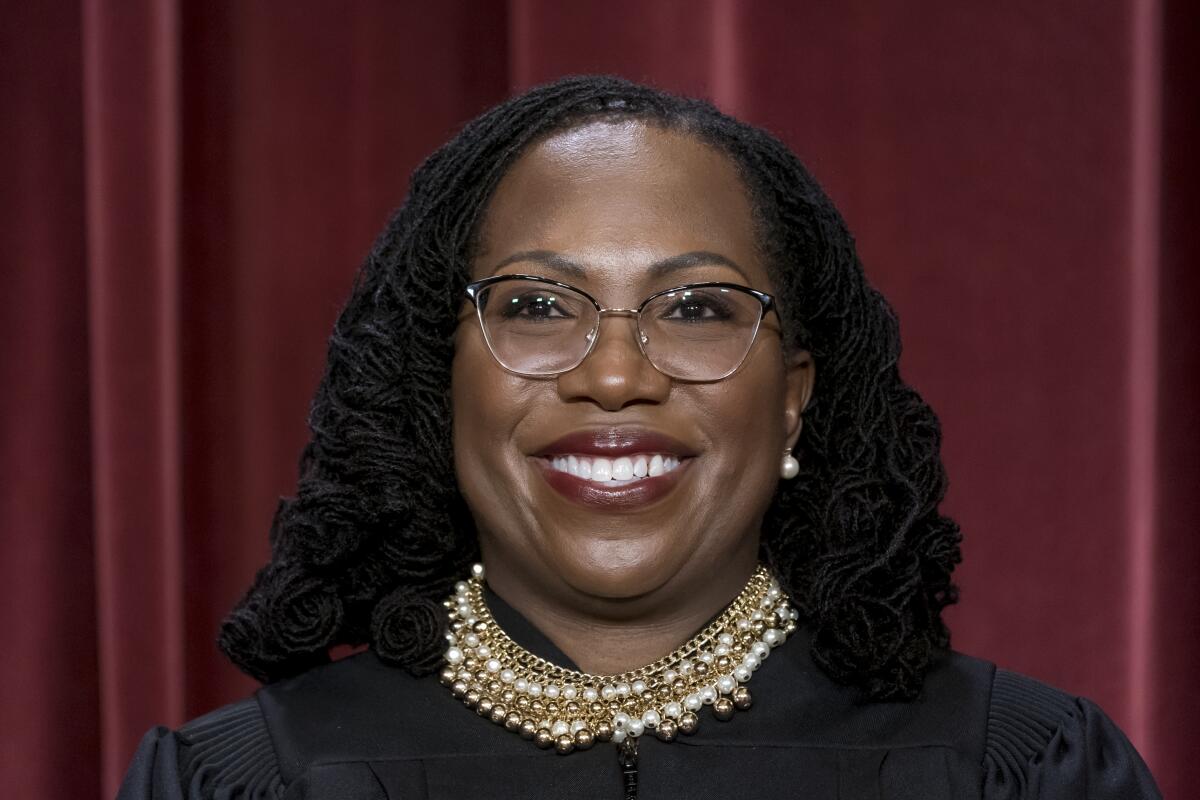Column: On affirmative action, Justice Jackson blasts her colleagues’ ‘let-them-eat-cake obliviousness’

- Share via
There is no way around this: The Supreme Court’s split decision overturning affirmative action in college admissions is a perfect example of how racial diversity enriches us, and why it should be enshrined as a goal in our laws.
Writing for the conservative majority in cases involving the admissions policies of Harvard College and the University of North Carolina, Chief Justice John Roberts paints a picture of a country where all have an equal start, where individuals are responsible for their own fates, where systemic racism not only doesn’t matter but really doesn’t even exist at all. Oh sure, he glancingly regrets horrendous Supreme Court decisions of yore, such as Plessy vs. Ferguson, which affirmed the doctrine of “separate but equal.”
But that’s all in the past, people!
Affirmative action, the court has declared, is incompatible with the equal protection clause of the 14th Amendment.
“Eliminating racial discrimination means eliminating all of it,” Roberts writes, as if centuries of discrimination that favored white people have not produced a legacy that hobbles people of color, especially Black people, today.
“At the risk of stating the blindingly obvious,” wrote Justice Ketanji Brown Jackson in a scathing — dare I say Scalia-esque — dissent, “the Fourteenth Amendment was intended to undo the effects of a world where laws systematically subordinated Black people and created a racial caste system.”
We’re all created equal?
Wouldn’t it be pretty to think so?
In their dissents, Justice Sonia Sotomayor and Jackson see the world through an entirely different lens from the majority. As women of color who presumably do not take all-expenses-paid vacations with white billionaires, they bring a diversity of viewpoint to the court that is healthy and necessary.
Saying no to gifts and offers isn’t that hard, especially when your job and an institution’s credibility is on the line.
Jackson argues persuasively that we are not even close to living in a country where all are on an equal playing field, and that “holistic” admissions policies that take race into account as one factor are important steps toward a more equal world.
“With let-them-eat-cake obliviousness, today, the majority pulls the ripcord and announces ‘colorblindness for all’ by legal fiat,” writes Jackson. “But deeming race irrelevant in law does not make it so in life.”
She asks us to imagine two college applicants from North Carolina: John, who is white, would be the seventh generation of his family to attend the University of North Carolina. James, who is Black and most likely descended from enslaved forebears, would be the first member of his family to attend college. “Does the race of these applicants properly play a role in UNC’s holistic merits-based application process?” she asks. The school has no racial quota system. It only takes race into account as one of many factors.
Depositing South American asylum seekers on the steps of a Sacramento church is cowardly, cruel and potentially illegal.
Our newest justice offers a history lesson to her fellow conservatives about why it should. “A page of history is worth a volume of logic,” she writes, quoting Justice Oliver Wendell Holmes. Her insinuation: The majority cannot see the forest for the trees.
“Given the lengthy history of state-sponsored, race-based preferences in America” (which have always favored white people), she writes, “to say that anyone is now victimized if a college considers whether that legacy of discrimination has unequally advantaged its applicants fails to acknowledge the well documented ‘intergenerational transmission of inequality’ that still plagues our country.”
She lists the familiar ways that the prosperity of Black Americans has been hindered by laws and government policies.
Sharecropping prevented freed Black people from attaining property and prosperity. Vagrancy laws criminalized free Black men. Racially exclusionary zoning, redlining, the inability of Black people to qualify for FHA loans or obtain credit. Between the boom years of 1934 and 1968, Jackson notes, 98% of FHA loans went to white Americans. The ensuing wealth disparity continues to be stark. Gaps in health outcomes and educational achievement persist.
“For present purposes,” she writes, “it is significant that, in so excluding Black people, government policies affirmatively operated — one could say, affirmatively acted — to dole out preferences to those, who if nothing else, were not Black.” (Italics mine.)
Dr. Caitlin Bernard, an Indiana OB-GYN who treated a pregnant 10-year-old from Ohio, should never have been called before a medical board in the first place.
For most of this country’s history, being Black was an automatic disqualifier to college admission (and so much else).
“Holistic programs,” writes Jackson, “reflect the reality that Black students have only relatively recently been permitted to get into the admissions game at all. Such programs also reflect universities’ clear-eyed optimism that, one day, race will no longer matter.”
It does seems like a contradiction, she notes, but the only way we’ll become a country where all races are equal is by taking race into account to correct historical inequities.
We are at a bizarre moment in the racial history of America.
The Supreme Court has ruled against colleges taking the race of applicants into consideration, yet, at the very same time, many serious discussions about reparations for the descendants of enslaved Americans are taking place, in California and elsewhere.
ProPublica reported on Thomas’ undisclosed private jet and yacht trips, now it says he failed to disclose real estate transactions. Who will hold him accountable?
And yes, it’s true that most Americans oppose the concept of reparations. Of course they do. When you have benefited from the color of your skin over generations, or do not care to recognize that others have been and continue to be penalized, it’s very easy to believe that everyone has an equal shot at health, wealth and education.
That is not true and never was.
It’s a shame that our conservative Supreme Court justices have to pretend otherwise.
More to Read
A cure for the common opinion
Get thought-provoking perspectives with our weekly newsletter.
You may occasionally receive promotional content from the Los Angeles Times.
















